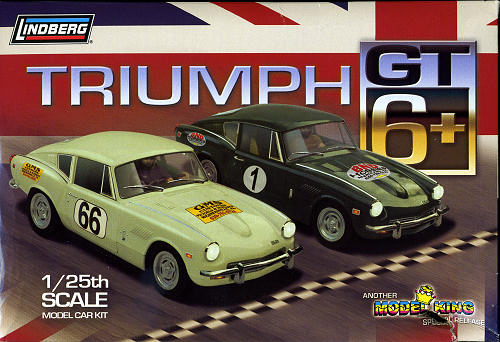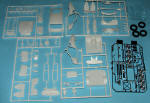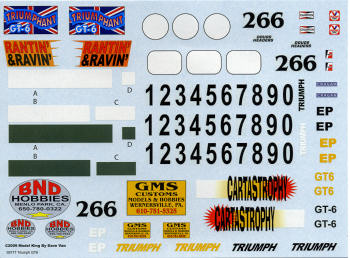
Lindberg 1/25 Triumph GT6+
| KIT #: | 95777 |
| PRICE: | $19.15 from GreatModels |
| DECALS: | Many options, all bogus |
| REVIEWER: | Scott Van Aken |
| NOTES: | Reissue via Model King |

| HISTORY |
In early 1963 Giovanni Michelotti was commissioned by Standard-Triumph to design a GT version of their recently introduced Spitfire 4 (also designed by Michelotti). An unmodified Spitfire 4 was transported to Michelotti's design studios in Italy and late in 1963 the prototype Spitfire GT4 was returned to England for evaluation. The styling of the vehicle was a success but unfortunately the extra weight of the GT bodyshell resulted in extremely poor performance, with the 1,147 cc (70 cu in) Spitfire power unit, and plans for producing the Spitfire GT4 were shelved.
However, Michelotti's fastback design for the Spitfire GT4 prototype was (for the 1964 season) adopted by the Triumph racing-programme as it was deemed to provide an aerodynamic benefit over the standard Spitfire body-shape. Fiberglass copies of the Spitfire GT4's fastback were grafted on to the race-modified Spitfires destined for competition. The Spitfire racing-programme was successful and, in 1965, resulted in a 1st in category at the prestigious Le Mans 24 Hour (beating their main rivals, the MG Midgets). The competitive success of the Spitfire racing-programme, as well as the continued commercial success of the production vehicle led Triumph to reevaluate its shelved plans for a GT version of the Spitfire. To overcome the lack of performance inherent in the heavier body-style the Spitfire's 4 cylinder engine was replaced with the more powerful 2 litre 6 cylinder engine from the Triumph Vitesse (which shared a similar chassis with both the Spitfire and Triumph Herald). The car was further developed and refined and eventually launched as the Triumph GT6 (dropping the "Spitfire" prefix) to identify its GT styling and its 6 cylinder engine.
Contemporary Triumph marketing advertised the GT6 as being developed from the "race winning Le Mans Spitfires" to capitalise on their aesthetic similarities, whereas the Le Mans Spitfires and the GT6 were actually two entirely separate development programmes (the GT programme predating the racing programme). However, the marketing spin was so successful that many people erroneously believed the Le Mans Spitfires to actually be GT6s.
The new car was introduced in 1966 and called the Triumph GT6. The new body was a sleek fastback design with an opening rear hatch (This gave the GT6 the nickname "Poor man's E-Type"). It was really a 2-seater, but a small extra rear seat could be ordered if required and was large enough for small children. The family resemblance to the Spitfire Mk II was strong, the longer 6-cylinder engine necessitated a new bonnet top with a power bulge and the doors were provided with opening quarter light windows and squared-off glass in the top rear corner. The 6-cylinder engine was tuned to develop 95 bhp (71 kW) and necessitated certain changes to the Spitfire mechanics; the radiator was new and mounted further forward in the car and the gearbox was the stronger unit from the Vitesse, with optional overdrive. Front springs were uprated to cope with the extra weight from the new engine. The interior of the GT6 was well equipped; a wooden dashboard housed a full complement of instruments, with carpets and heater included as standard.
The new car had some very strong selling points. The new engine provided a 106 mph (171 km/h) top speed and 0-60 mph in 11.7 seconds, a little better than the MGB GT. Moreover, the unit was comparatively smooth and tractable, in marked contrast to the MG's rather harsh 4-cylinder motor. Fuel economy was very reasonable for the period and the interior well up to the competition. The only major criticism was of its rear suspension; the GT6 inherited the swing-axle system from the Spitfire, which in turn was copied from the Herald small saloon. In the saloon it was tolerated, in the little Spitfire it was not liked and in the powerful GT6 it was heavily criticised. Triumph had done nothing to improve the system for the GT6 and the tendency to break away if the driver lifted off the power mid-corner was not helped at all by the increased weight at the front of the car. The handling was most bitterly criticised in the USA, an important export market for Triumph, where they were traditionally very strong. Similar criticism was being levelled at the Vitesse saloon, which shared both the GT6's engine and it's handling problems.
There were other changes for the MK2: the front bumper was raised (in common with the Spitfire Mk.3) to conform to new crash regulations, necessitating a revised front end, and side vents were added to the front wings and rear pillars. Under the bonnet, the engine was uprated to develop 104 bhp with a new cylinder head, camshaft, and manifolds. The interior was also updated with a new dashboard and better ventilation, a 2-speed heater fan and a black headlining. Overdrive remained a popular option.
| THE KIT |
 Though
the box says Lindberg and the kit was produced by them, it is brought to us by a
company that has no production facilities, Model King. Model King and some
others will contact a company, such as Lindberg or AMT, about producing
older kits, complete with packaging, instructions and decals. This has the
benefit of allowing what were very high priced collector's kits to be newly
available at price that, while greater than if normally issued, is considerably
less than the collector's prices. So it is with this kit of the Triumph GT6+.
Interestingly, Stevens Int'l did this with several Monogram kits and for
whatever reason, Revell-Monogram will no longer produce kits in this manner.
Though
the box says Lindberg and the kit was produced by them, it is brought to us by a
company that has no production facilities, Model King. Model King and some
others will contact a company, such as Lindberg or AMT, about producing
older kits, complete with packaging, instructions and decals. This has the
benefit of allowing what were very high priced collector's kits to be newly
available at price that, while greater than if normally issued, is considerably
less than the collector's prices. So it is with this kit of the Triumph GT6+.
Interestingly, Stevens Int'l did this with several Monogram kits and for
whatever reason, Revell-Monogram will no longer produce kits in this manner.
It comes in those horrible one-piece flip lid boxes that are so popular with some companies. I understand why they are produced, but would much rather have a standard two piece box. Inside are all the bits. Most of the sprues are in white with a nicely done chrome sprue, a clear sprue that is a touch cloudy, and four very hard vinyl tires. No clear red bits for the tail lights as those are molded on the body.
The condition of the sprues is very good. There is some flash, but it is quite minor. No sink areas were noticed. There are a number of ejector pin marks and several of them are on the chrome pieces. However, since most modelers strip and repaint chrome bits, these marks can be cleaned up at the same time. Many of the parts have the part number embossed on them, which is a bit of a help.
This is not a curbside and the kit is designed so the hood and doors can be opened and closed. The car's 6 cylinder engine is nicely done, though many of the details are molded in place. But then, this is a 30 plus year old kit. The interior is quite complete, even including seat belts, something one rarely sees in car kits. Suspension is well done and appears to be rather sturdy. There isn't the mass of small parts making up the suspension so that enhances the sturdiness of the construct. The body is in several parts with a separate hood, side pieces and upper piece for the roof and rear. As mentioned, the tires are separate and a rather stiff vinyl material.
 There
are also extra 'custom' pieces to make a dragster, complete with wheelie bars,
but no drag slicks are included which makes it rather an odd choice. There are
also added hood scoops and side exhaust like on a mid-60's Corvette that look
very much out of place on this car.
There
are also extra 'custom' pieces to make a dragster, complete with wheelie bars,
but no drag slicks are included which makes it rather an odd choice. There are
also added hood scoops and side exhaust like on a mid-60's Corvette that look
very much out of place on this car.
Instructions are well done with the usual generic paint references. Apparently, Model King would have you do this as a racing car, despite not having racing wheels, a roll bar and racing tires, as the very large decal sheet includes a number of sponsor options and other stickers. Perhaps these were included with the original kit as something kids would consider 'cool'. The vast majority of current modelers will undoubtedly consign this nicely printed, but rather inappropriate sheet to the spares pile.
| CONCLUSIONS |
To be honest, I don't ever recall seeing this kit when it first came out, but am glad that it has been reissued. Though the GT6+ version isn't as esthetically pleasing as the original, thanks to the revised bumpers, it is still a good looking car and one that I had on my 'wish I could afford it' list when I was a teenager! I think that you'll find it to be equally pleasing.
As a final note, I've been informed by several that this was originally released by Pyro, and isn't a Lindberg molding at all.
| REFERENCES |
http://en.wikipedia.org/wiki/Triumph_GT6
December 2009
You can find this and many other fine kits and accessories at www.greatmodels.com
If you would like your product reviewed fairly and quickly, please contact me or see other details in the Note to Contributors.